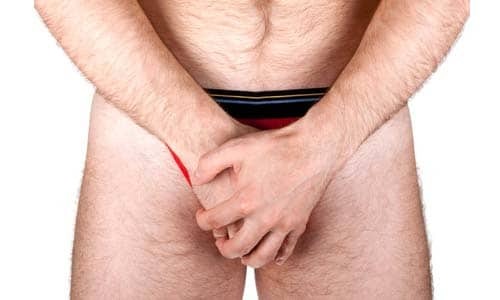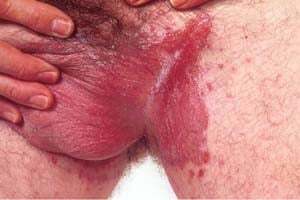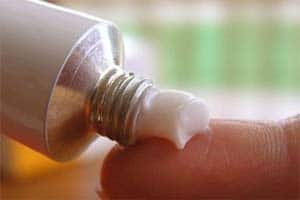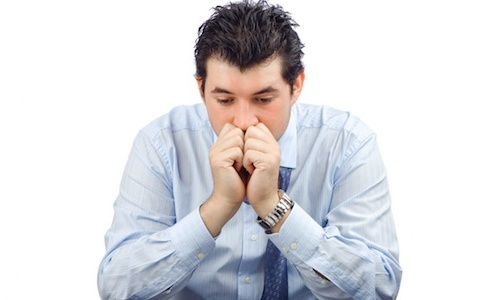Fungal pathologies occur in both sexes, but here the fungus in the groin in men is detected much more often than in women. This selectivity is due to a more intense sweating of men, because they often perform heavy physical work. Men often visit baths, gyms and saunas, where you can pick up a similar fungal disease, which is often called inguinal epidermophyte or dermatomycosis.

Features of the inguinal fungus
Pathogenic fungi can settle in a variety of areas of the body, however, they prefer to develop on the nails, feet and groin. Many factors contribute to the formation of such a fungal infection:
- Hyperhidrosis or excessive sweating in the inguinal zone;
- Hot climatic conditions or work in rooms with high temperature and humidity;
- Failures in lipid-carbohydrate metabolic processes;
- Excessive humidity in the groin area due to poor personal hygiene.
Usually fungal infections choose for localization such places, where for their development there are favorable conditions. Nature provides protection of the sexual organs from hypothermia, therefore in the inguinal zone the temperature is slightly higher than in open areas.
If you neglect a man's intimate hygiene in the inguinal folds, conditions arise due to high humidity and temperature. Such an atmosphere and provides a favorable environment for fungal processes. Therefore, in the groin such lesions are very common. They can spread to the surface of the scrotum, anal area and genitals.
Causes of epidermophytosis
 The most common risk of inguinal fungus is men who live in hot climates, who suffer hypertension or mycosis in their feet, who have low stress tolerance and endocrine pathologies such as metabolic disorders, obesity or diabetes. In addition, men who are regulars of public saunas, swimming pools and baths or who suffer from cardiovascular disorders are often subjected to inguinal epidermophyte.
The most common risk of inguinal fungus is men who live in hot climates, who suffer hypertension or mycosis in their feet, who have low stress tolerance and endocrine pathologies such as metabolic disorders, obesity or diabetes. In addition, men who are regulars of public saunas, swimming pools and baths or who suffer from cardiovascular disorders are often subjected to inguinal epidermophyte.
Inguinal yeast fungus( most often candida) refers to a group of microbes of opportunistic origin. On the skin it exists in a saprophytic form, feeding on dead particles of the epithelium. But under the influence of the above-described factors, it is able to degenerate into a pathogenic form. Provoke the activity of the fungus can and antibiotic therapy, the use of hormonal drugs, cytotoxic drugs and other medications. Even a sudden decrease in immune defense is fraught with the development of fungal processes. Similar often occurs against a background of organic infections of a chronic form.
You can get infected with a fungus in the process of sexual intimacy, when using a bed or a towel with an infected person. Even wearing close synthetic smelting can lead to the development of inguinal fungus. If the body of a man experiences vitamin deficiency of retinol, tocopherol and B-group vitamins, then the man also risks getting dermatomycosis.
Symptoms and signs of fungus in the groin area
 It is very easy to recognize the presence of fungal lesions, because such processes are characterized by eloquent symptoms. The pathological process begins with the appearance of a red patchy spot, the surface of which can be peeled off. Then there are additional signs:
It is very easy to recognize the presence of fungal lesions, because such processes are characterized by eloquent symptoms. The pathological process begins with the appearance of a red patchy spot, the surface of which can be peeled off. Then there are additional signs:
- Spreading of formed spots and darkening of their surface;
- Education causes the strongest itching sensations, up to painful burning and tingling. The itch first has a periodic character, but eventually it begins to bother constantly, reaching the anal area;
- On the spots appear fluid filled with fluid, small blisters or pustules, papules or pustules;
- Then the rashes spontaneously open, and a lot of erecting erosive ulcers form;
- As the skin surfaces in the inguinal fold constantly rub against each other, the friction that is created provokes the spread of the fungal process to larger areas;
- On the site of the fungal attack, there are peeling areas where microcracks begin to appear actively.
Diagnostic tests take a scraping from the affected area, in which fungi are found. In the area bordering the affected zone, too, the peeling begins gradually, reddish puffiness appears. So fungal lesions spread to larger areas.
The pattern of inguinal dermatomycosis has a pronounced character, but it is only a certified and practicing specialist who can reliably diagnose the fungus. Therefore, if such manifestations occur, it is recommended to visit a dermatologist.
Methods for the elimination of fungal lesions
 Usually, inguinal epidermophytic treatment is performed at home using topical preparations. The most effective is the use of ointments with antifungal effect. Additional treatment is provided by taking antihistamines. Often the effectiveness of the prescribed therapy increases with the additional use of folk methods.
Usually, inguinal epidermophytic treatment is performed at home using topical preparations. The most effective is the use of ointments with antifungal effect. Additional treatment is provided by taking antihistamines. Often the effectiveness of the prescribed therapy increases with the additional use of folk methods.
From ointment funds, preparations based on clotrimazole, terbinafine, miconazole and the like are usually prescribed. The most popular means of this group are ointments Triderm or Mikozolone. With this method of therapy, it is recommended to strictly follow the rules of intimate hygiene, which assume a daily change of underwear and frequent washing out of the affected area with soap. According to experts, the duration of therapy is at least 2 weeks.
Can prescribe and treat antimycotic tablets such as terbinafine, clotrimazole or ketoconazole, nystatin and fluconazole, itraconazole, etc. Also in antifungal therapy, antihistamines like Suprastin and Pipolphen, Diazolin and Dimedrol are also used. In addition, it is recommended to treat the area affected by inguinal fungus, iodine solution, sulfur-tar ointment compresses, lotions with resorcinol or silver nitrate, calcium chloride.
Some features of the healing process
Before applying the ointment preparation, rinse the affected area with soap and then apply the ointment. When applying, you need to grab a little and healthy tissue surrounding the fungal lesion. If there is no efficacy from the prescribed therapy after a 2-week treatment period, it is necessary to consult a dermatologist about the replacement of the drug.
For the duration of the entire treatment period, the affected area should be kept dry. To do this, it is recommended to use talc or baby powders. Vegetation in the place of the fungal rash is best removed.
Warning! The fungus must be cured to the end, otherwise the lesions will appear again. The final recovery occurs when the symptomatology passes and there are no signs of fungus during microscopic examination.



